
Cotyledon is one of some 35 genera of succulent plants in the family Crassulaceae. Mostly from Southern Africa, they also occur throughout the drier parts of Africa as far north as the Arabian Peninsula. Ten of its species are mostly confined to South Africa, where unlike Tylecodon, they occur commonly in both the winter and summer rainfall regions. They may be found on coastal flats and rocky hillsides, or as cremnophytes on cliff faces. Their decussate, evergreen leaves are very variable in shape, even within some species, but the flowers are, apart from colour, very similar.

Crassula tetragona is a succulent plant native to Southern Africa. It is widely distributed from the Orange River boundary of Namaqualand to beyond the Kei River in the Eastern Cape. "Tetragona" comes from the phyllotaxy of the leaves. It is popularly named the "miniature pine tree" among ornamental plant enthusiasts, for its popular use as a "pine tree" in Bonsai.

AnacampserosL. is a genus comprising about a hundred species of small perennial succulent plants native to Southern Africa, Ethiopia and Latin America. The botanical name Anacampseros is an ancient one for herbs supposed to restore lost love.
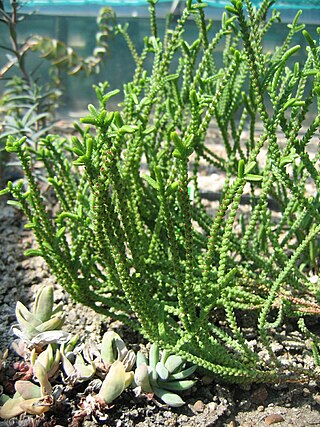
Crassula muscosa, synonyms Crassula lycopodioides and Crassula pseudolycopodioides, is a succulent plant native to South Africa and Namibia, belonging to the family of Crassulaceae and to the genus Crassula. It is a houseplant grown worldwide and commonly known as rattail crassula, watch chain, lizard's tail, zipper plant and princess pines.

Crassula capitella, is a perennial succulent plant native to southern Africa.

Crassula ovata, commonly known as jade plant, lucky plant, money plant or money tree, is a succulent plant with small pink or white flowers that is native to the KwaZulu-Natal and Eastern Cape provinces of South Africa, and Mozambique; it is common as a houseplant worldwide. Much of its popularity stems from the low levels of care needed; the jade plant requires little water and can survive in most indoor conditions. It is sometimes referred to as the money tree; however, Pachira aquatica also has this nickname.

Crassula nudicaulis is a succulent plant native to South Africa, and Lesotho.

Crassula cotyledonis is a succulent plant endemic to the arid Namaqualand and Karoo regions of South Africa.
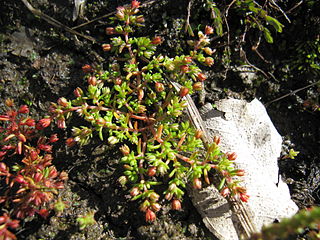
Crassula decumbens, commonly known as rufous stonecrop, cape crassula or spreading crassula, is a herb in the family Crassulaceae that is native to southern parts of Australia, South Africa, and Chile. There are generally two accepted varieties: Crassula decumbens var. decumbens and C. decumbens var. brachyphylla.
Crassula natans, commonly known as floating pigmyweed, is a herb in the family Crassulaceae.
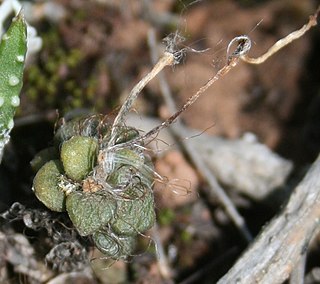
Anacampseros retusa is a species of succulent plant native to the Northern Cape and Western Cape Provinces of South Africa, as well as to Namibia.

Crassula brevifolia is a succulent plant native to the arid western edge of South Africa as well as southern Namibia.
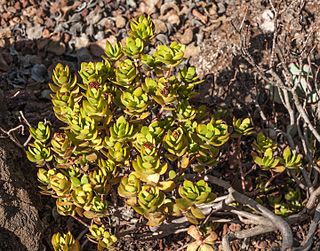
Crassula cultrata is a succulent plant native to the southern parts of South Africa.
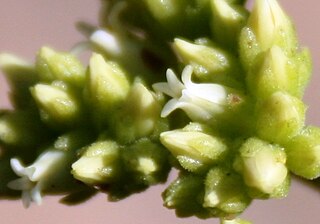
Crassula atropurpurea is a succulent plant, very common and widespread in the southern Karoo regions of South Africa and Namibia.
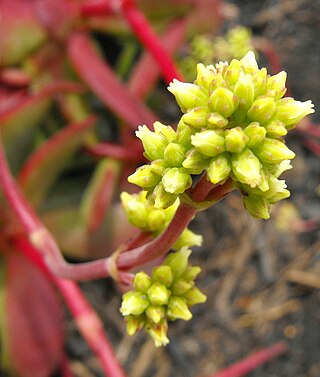
Crassula pubescens is a succulent plant, common and widespread in the southern Karoo regions of South Africa.

Crassula biplanata is a succulent plant native to rocky ledges and mountainous areas in the southern parts of South Africa.

Tylecodon wallichii is a species of succulent plant in the genus Tylecodon belonging to the family Crassulaceae. The species is named in honour of Nathaniel Wallich, early 19th century Danish plant hunter, botanist and physician.

Tylecodon reticulatus is a species of succulent plant in the genus Tylecodon belonging to the family Crassulaceae.

Tylecodon paniculatus, also known as butter bush, butter tree, butterboom or rooisuikerblom (Afrikaans), is a species of succulent plant in the genus Tylecodon belonging to the family Crassulaceae.
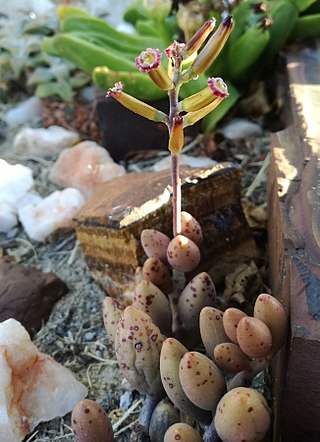
Adromischus filicaulis is a perennial, succulent plant in the family Crassulaceae. It is commonly called brosplakkies in Afrikaans. The species is endemic to South Africa and Namibia.






















